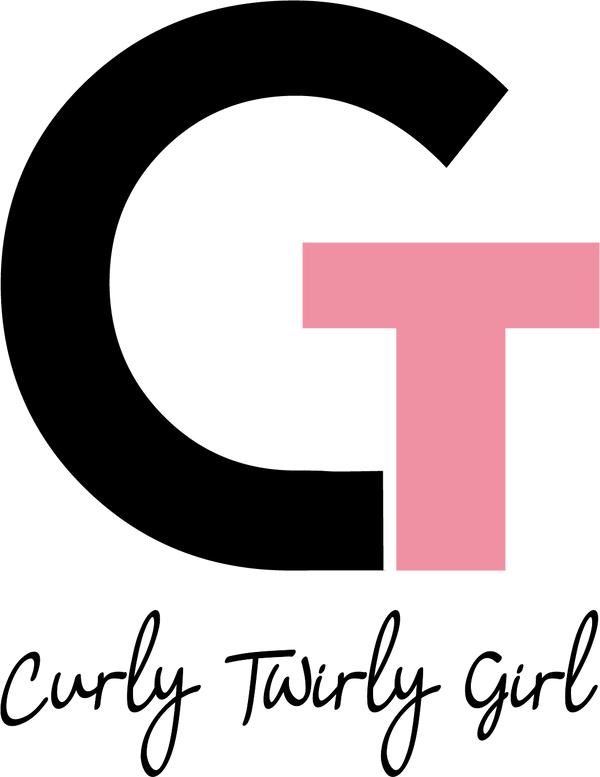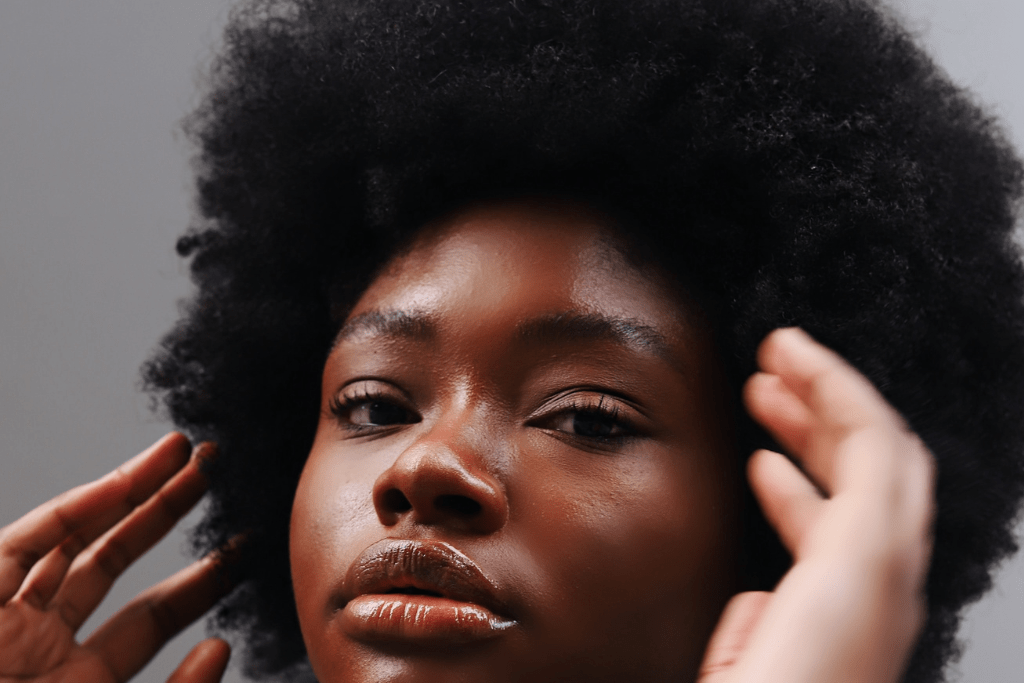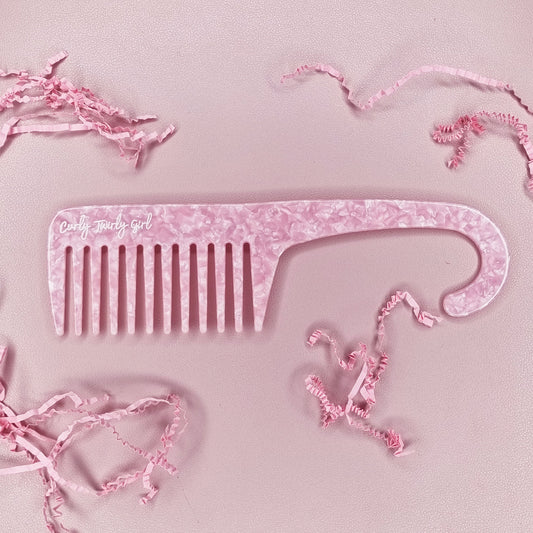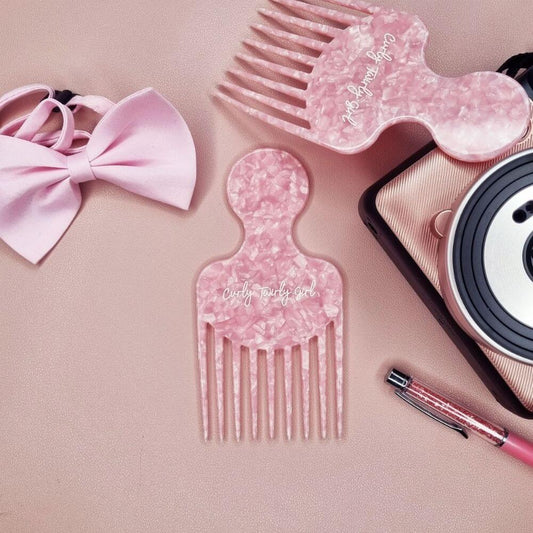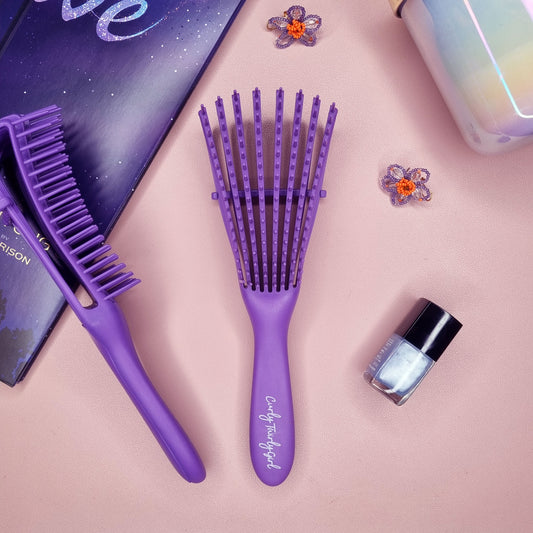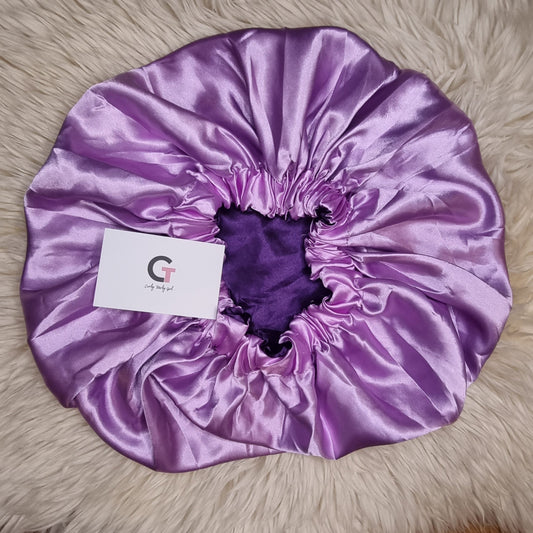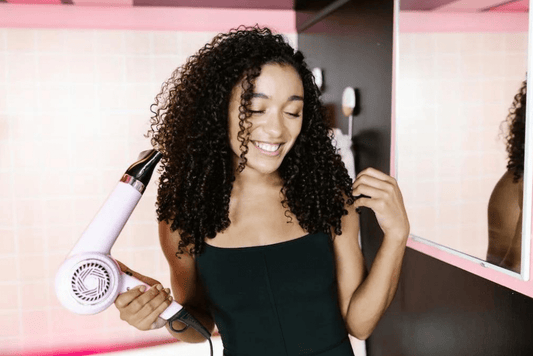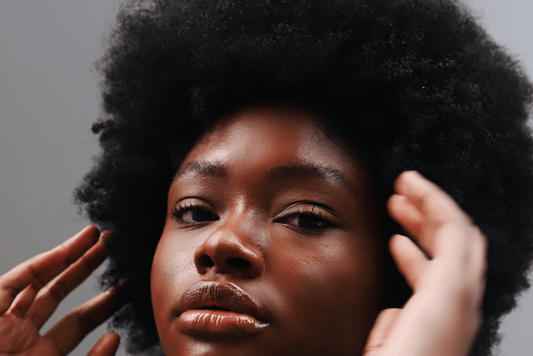If you have gorgeous 4C hair, you're likely aware that your beautiful strands demand unique attention. So, how do you go about caring for 4C hair, and what exactly does 4C hair look like?
These wonderfully tight coils require dedicated routine, be it for washing, styling, or bedtime. When it comes to nurturing your 4C curls, understanding the unique needs of your hair type is crucial for maintaining its health and vitality.
In this guide, we'll delve into 4C hair, and the essential tips for keeping it healthy, and the best hair care routine for this curl pattern.
What is 4C Hair?
4C hair is a distinctive curl pattern characterised by tight coils. 4C hair boasts incredible versatility, allowing for various styling options.
How to know if you have 4C hair
You know if you have 4C hair with the following:
Tight Curl Pattern: 4C curls are characterised by a tight coil pattern that forms a unique "Z" or "S" shape.
Shrinkage: 4C hair tends to experience significant shrinkage, meaning that the hair appears shorter than its actual length when dry.
Texture: The texture of 4C hair is densely packed, giving a fuller appearance.
Versatility: Hair is versatile and can be styled in various ways, including twists, braids, and afro styles.
Moisture Reliant: Due to the tight coil pattern, 4C hair often requires consistent moisture to prevent dryness and breakage. Regular deep conditioning is essential.
Minimal Definition: These curls often have minimal definition, showcasing densely packed coils that create a beautiful texture.
Don't know your curl pattern? Read our Curl Type guide to find out.

Tips for Keeping 4C Hair Healthy
Maintaining the health of your 4C hair requires a tailored approach. Here are some essential tips:
1. Moisture is Key:
4C hair tends to be dry, so hydration is crucial. Use a sulfate-free, hydrating shampoo and a rich conditioner to keep your hair well-moisturized to retain moisture and prevent breakage.
2. Deep Conditioning:
Incorporate regular deep conditioning sessions to nourish your hair and enhance elasticity. Look for products containing natural oils like shea butter and argan oil.
3. Protective Styles:
Although nothing compares to wearing your natural coil out in all its glory, protective styles such as braids, twists, or bantu knots can help minimise manipulation and promote hair growth.
4. Gentle Detangling:
Use a wide tooth comb or your fingers to detangle your hair gently. This prevents unnecessary breakage and helps maintain length. Start from the tips and work your way up to the roots to prevent unnecessary breakage.
Read our tips on how to use a wide tooth comb
5. Regular Trimming:
Trim your hair regularly to get rid of split ends and prevent breakage. This promotes healthier and more vibrant hair growth.
6. Moisturise and Seal:
Moisturise your hair regularly with water or a leave-in conditioner, and seal in the moisture with oils like jojoba oil, coconut oil, or castor oil.
7. Low-Manipulation Styling:
Opt for low-manipulation hairstyles to reduce stress on the hair. Styles like twists, braids, or bantu knots can protect your curls while promoting growth.
8. Nighttime Care:
Wear a satin or silk scarf, or use a satin bonnet, to protect your hair while sleeping. This prevents friction and helps retain moisture.
9. Balanced Diet:
Maintain a well-balanced diet rich in vitamins and minerals, as nutrition plays a vital role in the health of your hair.
10. Avoid Heat and Harsh Chemicals:
Minimise the use of heat styling tools, and be cautious with chemical treatments. These can strip the hair of its natural moisture and lead to damage.
11. Regular Scalp Massages:
Stimulate blood circulation to the scalp with regular massages, using your hands or a tool like a scalp massager. This promotes a healthy scalp environment for optimal hair growth.
Read our benefits of a scalp massage brush.
12. Curl Pattern Understanding:
Understand your unique curl pattern. This knowledge can guide your product choices and styling techniques for better results.
13. Professional Care:
Schedule regular visits to a professional stylist experienced with 4C hair. They can provide personalised advice and help maintain the health of your hair.
Caring for 4C hair involves a combination of hydration, protection, and gentle handling. Tailor your routine to suit the specific needs of your hair, and embrace the beauty of your natural curls.
Essential Tools for 4C Hair
Caring for 4C hair requires the right tools to handle its unique texture and characteristics. Here are essential tools for 4C hair care:
Wide-Tooth Comb:
A wide-tooth comb is crucial for gentle detangling. It helps prevent breakage and minimises stress on tight coils. Discover our range of wide tooth combs. 
Detangling Brush:
A detangling brush with flexible bristles is another option for easing out knots and tangles without causing damage.
Satin or Silk Pillowcase:
Sleeping on a satin or silk pillowcase reduces friction, helping to retain moisture and prevent breakage as 4C hair tends to be more prone to dryness.
Satin Bonnet or Scarf:
A satin bonnet or scarf is essential for protecting your hair while sleeping. It helps maintain moisture and prevents friction that can lead to breakage.
Spray Bottle:
A spray bottle filled with water helps keep your hair moisturized. Regular spritzing can revive your curls and make styling more manageable.
Microfiber Towel:
Instead of a traditional cotton towel, opt for a microfiber towel. Microfiber is gentler on the hair and reduces frizz.
Silicone-Free Hair Ties:
Silicone-free hair ties or scrunchies are gentle on 4C hair and minimize the risk of breakage when securing hairstyles.
Hair Clips or Bobby Pins:
Use hair clips or bobby pins for sectioning your hair during styling. They make the process more organised and prevent unnecessary tugging.
Deep Conditioning Cap:
A deep conditioning cap or thermal heat cap enhances the effectiveness of deep conditioning treatments by trapping heat and allowing the product to penetrate the hair shaft.
Spray Detangler:
A leave-in detangler spray helps ease the detangling process, making it smoother and reducing the risk of breakage.
Edge Brush or Toothbrush:
An edge brush or old toothbrush is handy for styling and laying down baby hairs or edges when desired.
Hair Dryer with Diffuser Attachment:
When using heat, a hair dryer with a diffuser attachment is useful for drying your hair without causing frizz or disrupting your natural curl pattern.
Sectioning Clips:
Sectioning clips are helpful for dividing your hair into manageable sections during washing, conditioning, and styling.
Silicone-Free Heat Protectant:
If you use heat styling tools, a silicone-free heat protectant is essential to shield your hair from potential damage.
Soft Boar Bristle Brush:
A soft boar bristle brush can help smooth the hair and distribute natural oils from the scalp.
Remember to choose tools that are suitable for your hair's specific needs, and always handle your 4C hair with care to maintain its health and natural beauty.
What Not to Do with 4C Hair
Avoiding certain practices is equally important:
-
Over-styling: Over-styling, whether through frequent braiding, twisting, or using tight hairstyles, can lead to breakage. Give your hair time to rest between styles to minimise stress.
-
Harsh Chemicals: Harsh chemicals in relaxers, perms, and colour treatments can weaken the hair structure. Minimise their use to preserve the natural integrity of your curls.
-
Cautious Heat Styling: While occasional heat styling is acceptable, excessive use of heat tools can cause damage. Use a heat protectant, and try to air-dry or use the lowest heat settings.
-
Tight Styles: Styles that pull the hair tightly, such as tight ponytails or braids, can cause stress on the hairline and lead to breakage. Opt for looser styles to prevent unnecessary tension.
-
Neglecting Moisture: 4C hair tends to be dry, so neglecting moisture is a big no. Regularly moisturise your hair with water-based products and seal in the moisture with oils or butters.
-
Ignoring Scalp Health: A healthy scalp is crucial for healthy hair growth. Don't ignore your scalp—cleanse it regularly, massage to stimulate blood circulation, and address any scalp issues promptly.
-
Rough Towel Drying: Traditional towels can cause friction and frizz. Instead of vigorously rubbing your hair, pat it gently with a microfiber towel to absorb excess water.
-
Ignoring Protective Styling: While tight styles can be damaging, neglecting protective styles altogether can lead to increased manipulation and breakage. Strike a balance with low-tension protective styles.
-
Skipping Regular Trims: Regular trims are essential for preventing split ends and promoting overall hair health. Don't skip them to maintain the integrity of your hair.
-
Using Products with Harsh Ingredients: Some hair products contain harsh ingredients that can strip moisture from 4C hair. Avoid products with sulfates, alcohol, and other potentially damaging substances.
- Ignoring Individual Curl Needs: Each person's 4C hair is unique. Understand your individual curl pattern, porosity, and texture to tailor your hair care routine to its specific needs.
Remember, a gentle and consistent approach to care is key for maintaining the health and vibrancy of 4C hair. Pay attention to your hair's response to different practices and adjust your routine accordingly.
What is the Best 4C Hair Care Routine?
Establishing the best 4C hair care routine involves a combination of washing, moisturising, and protective styling to ensure your curls remain healthy and vibrant. Here's a comprehensive routine for both washing and styling 4C hair:
Washing Routine:
1. Pre-Shampoo Treatment:
Apply a pre-shampoo treatment with a mix of oils such as coconut oil, olive oil, or jojoba oil to add moisture and facilitate detangling.
2. Gentle Detangling:
Detangle your hair using a wide-tooth comb or your fingers before washing. Start from the tips and work your way up to minimise breakage.
3. Sulfate-Free Shampoo:
Use a sulfate-free shampoo to cleanse your hair. Focus on the scalp, gently massaging to remove dirt and product buildup.
4. Deep Conditioning:
Follow up with a deep conditioning treatment. Choose a product with moisturising ingredients like shea butter, avocado oil, or aloe vera. Use a shower cap and sit under a hooded dryer or wrap your hair with a warm towel for deep penetration.
5. Rinse with Cold Water:
Rinse the conditioner with cold water to help seal the hair cuticles and retain moisture.
6. Leave-In Conditioner:
Apply a leave-in conditioner to damp hair to keep it moisturised. Look for products with water as the first ingredient.
Styling Routine:
1. Moisturise:
Moisturise your hair regularly using water or a water-based leave-in conditioner. Ensure your hair is damp but not soaking wet.
2. Sealing:
Seal in moisture with an oil or butter. Popular choices include coconut oil, jojoba oil, or shea butter.
3. Protective Styles:
Embrace protective styles such as twists, braids, or bantu knots to minimise manipulation and protect your curls. These styles promote growth and protect the ends of your hair.
4. Low-Manipulation Styles:
Opt for low-manipulation styles during the week. This could include twist-outs, braid-outs, or simply wearing your hair in a loose, natural state.
5. Nighttime Care:
Protect your hair while sleeping by using a satin or silk scarf, or a satin bonnet. This prevents friction and retains moisture.
6. Regular Trims:
Schedule regular trims to get rid of split ends and maintain the overall health of your hair.
7. Scalp Health:
Pay attention to your scalp health. Massage your scalp regularly to stimulate blood circulation and promote healthy hair growth.
Read our tips for scalp health.
8. Professional Care:
Schedule periodic visits to a professional stylist experienced with 4C hair for trims and personalised advice.
By consistently following this washing and styling routine, you can cater to the unique needs of your 4C hair, ensuring it remains moisturised, healthy, and beautifully styled. Adjust the routine as needed based on your hair's response and any seasonal changes.
How to Style Natural 4C Hair?
Protective styles for 4C hair are essential for minimising manipulation, reducing breakage, and promoting hair health.

Here are some of the best protective styles for 4C hair:
-
Braids: Classic box braids, cornrows, or individual braids are versatile and protect your hair by keeping it tucked away. You can experiment with different braid sizes and patterns.
-
Twists: Two-strand twists or flat twists are excellent protective styles that can be worn for an extended period. They keep the hair moisturised and reduce the need for daily styling.
-
Bantu Knots: Bantu knots are not only a stylish protective option but also create beautiful curls when taken out. They protect the ends of your hair and add a unique flair to your look.
- Updos and Bun Styles: Elegant up-dos and buns are protective styles that keep your hair off your shoulders and reduce friction. You can experiment with various bun sizes and positions.
- Wigs and Extensions: Wearing wigs or extensions gives your hair a break from daily styling and manipulation. Ensure the wig or extension is not too tight to avoid stress on your hairline.
-
Crochet Braids: Crochet braids provide a protective style that allows for easy styling and versatility. You can choose from various hair textures and lengths.
-
Faux Locs: Faux locs offer a trendy and protective style that mimics the appearance of traditional locs without the commitment. They are gentle on your natural hair and can be styled in various ways.
-
Halo Crown: Create a halo crown by twisting or braiding the hair around the perimeter of your head. This style protects the ends while showcasing the natural beauty of your curls in the centre.
-
Roll, Tuck, and Pin Styles: Roll, tuck, and pin styles involve creating intricate updos by rolling or twisting sections of your hair and securing them with hairpins. These styles protect the ends and offer a polished look.
- Protective Head wraps and Scarves: Embrace head wraps or scarves as a protective style that not only shields your hair from environmental elements but also adds a touch of elegance to your appearance.
Remember to pair your protective styles with a proper moisturising routine and gentle handling to maximise their effectiveness in maintaining the health of your 4C hair.
Rotate between different styles to avoid tension on specific areas of your hair and give your hair a break between protective styles to ensure overall hair health.
Conclusion
As mentioned, 4C hair is a beautiful curl pattern that requires a dedicated and tailored approach to look after your curls and coils while preventing breakage and damage.
Visit our curly hair online store for curated tools that are gentle and of the highest quality for your coils today.
Do you have 4C hair? Let us know your top tips for maintaining your gorgeous coils.
